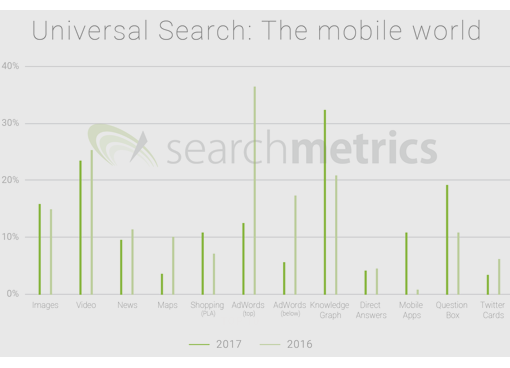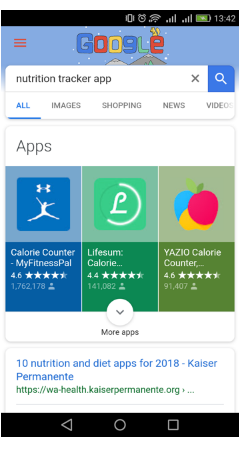Want more people to quickly see your app or website in mobile search results? There’s good news and bad news if you want to boost your mobile search rank. The bad news: mobile search results now show fewer “organic” links, or links that appear naturally due to search algorithms and site rankings. The good news: thanks to a boom in universal search box content like video boxes and app suggestions, you now have more “non organic” channels to get your app or website shown.
Google’s first-page or “page one” mobile search results now show fewer organic links, listing an average of 8.5 organic links instead of the previous 10 links, according to a new study from Searchmetrics. That’s because Google, Bing and other search engines now show us more “universal search boxes” such as Google’s “direct answers” boxes with content from Wikipedia or other highly-ranked sites, as well as boxes with relevant images, news results, videos, maps, airline flights, stock updates, song lyrics, and so on.
All of that universal search box content takes up more screen space, so we often need to scroll down farther to even see any traditional organic links on page one search results. And on small mobile screens, these universal search box results stand out even more, enticing people to click on them without scrolling as much.
Six mobile search rank tips: Universal search & AMP results
But the good news is that all of these new search box results present new opportunities to get your app or website content seen. Here are six tips from the study to help your mobile marketing strategies and mobile search rankings.
Direct answers in voice & mobile search results
 Four percent of Google mobile search results now feature a direct answers box, according to the Searchmetrics report. A direct answers box is shown when someone is looking for an answer to a specific question like ‘Flu symptoms’ or ‘How to plant roses’. Direct answers boxes appear high on the mobile screen, usually before scrolling.
Four percent of Google mobile search results now feature a direct answers box, according to the Searchmetrics report. A direct answers box is shown when someone is looking for an answer to a specific question like ‘Flu symptoms’ or ‘How to plant roses’. Direct answers boxes appear high on the mobile screen, usually before scrolling.
If you can get your content featured in direct answers box results, it’s not only great for mobile search rank and mobile traffic, but can also get you featured in voice search results on smart speakers. With ever more smartphones and smart speakers being sold, it’s estimated that at least half of all web searches will be by voice as soon as 2020.
The Google Home smart speaker, for example, only reads out one answer to a question—and it’s usually a direct answer in search results. Information in direct answer boxes usually comes from sites with high authority, with clear, well-ordered content using specific web code that helps Google’s crawlers to understand it.
Google app suggestions tips
 Google app suggestions boxes show up in 11% of mobile search results, according to Searchmetrics. This is usually when search queries relate to tasks or activities that can be supported by apps, such as ‘dating’, ‘banking’ and ‘music’. Clicking on a suggested app takes the searcher to the download store to install the app.
Google app suggestions boxes show up in 11% of mobile search results, according to Searchmetrics. This is usually when search queries relate to tasks or activities that can be supported by apps, such as ‘dating’, ‘banking’ and ‘music’. Clicking on a suggested app takes the searcher to the download store to install the app.
App suggestions are device-specific, so Android app suggestions only appear on Android devices, and iOS apps on iPhone or iPads. You can increase your chances of being included in app suggestions by writing highly relevant titles and descriptions for your app store listings, and by encouraging positive reviews.
Knowledge Graph results tips
Knowledge Graph boxes now show up in nearly a third (32%) of Google mobile search results, says Searchmetrics. Knowledge Graph boxes usually appear high in search results and include brief descriptions, images and relevant links when people are looking for a known brand, organization, place or person whether current, historical or fictional.
It’s important to remember that Google pulls text and images for Knowledge Graph boxes from relevant trustworthy sites like Wikipedia and other wiki sites, so if you have a wiki page, it’s a good idea to make sure its content is clear and well-organized. Google will also sometimes include contact details and links to a company’s own social media handles in Knowledge Graph boxes.
YouTube & Vimeo video boxes tips
 On Google, 16% of mobile searches trigger at least one video box integration on the first page of mobile search results, and the share of YouTube content in them has risen from 90% to 92% since 2016, says Searchmetrics.
On Google, 16% of mobile searches trigger at least one video box integration on the first page of mobile search results, and the share of YouTube content in them has risen from 90% to 92% since 2016, says Searchmetrics.
To get your content featured in video boxes, you’ll of course need to upload videos to YouTube, and then optimize your SEO by using the most relevant search keywords and phrases in your video titles and descriptions. (You can quickly check for popular keywords using Google Trends.) It also helps to include subtitles, which give Google a much better understanding of the content in the video. And Google is also more likely to display video boxes that show positive engagement such as likes and comments.
Google AMP results likely to grow
 Google Accelerated Mobile Pages (AMP), which are optimized to load faster on mobile phones, now appear in 21% of all organic results. Searchmetrics says that the universal search integration with the most AMP results are news boxes (78%), though non-news websites including ecommerce sites are also starting to adopt AMP.
Google Accelerated Mobile Pages (AMP), which are optimized to load faster on mobile phones, now appear in 21% of all organic results. Searchmetrics says that the universal search integration with the most AMP results are news boxes (78%), though non-news websites including ecommerce sites are also starting to adopt AMP.
Google’s Speed Update, which makes speed a ranking factor in mobile search results, is also likely to motivate more brands that want better AMP results and higher mobile search rank as part of their mobile marketing strategies.
Paid ads improve mobile search rank
If you have the budget, it can also pay off to pay for a higher mobile search rank. Google AdWords ads appear in more than one out of ten (12%) page one mobile search results, usually above the organic results. While the number of keywords for which ads appear has actually halved overall since 2016, this may actually be a sign that ads are better targeted at more relevant queries that indicate purchase intent.
These mobile search rank tips are culled from the Searchmetrics study “Universal Search 2018: It’s a Mobile World After All”. The study analyzes Google.com page one results for half a million popular search queries on desktop and mobile, and identifies the most frequently occurring universal search box integrations. Searchmetrics collected data for the study every month throughout 2017. You can download the study here.





